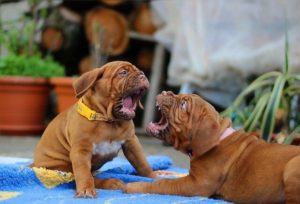Aggression in puppies is a rarer segment of the discussion on aggression. Basically, you don’t ever want to see true aggression in a puppy….or you could be headed for real problems in the adult dog.

Puppy time line
While every breed of dog is developed for something different and will end up with vastly different personalities in the end, all puppies start out fairly similar. You want to see a little pup have a happy outlook on the world and be outgoing with new people and in new situations. It doesn’t matter if this is a Labrador retriever or a rottweiler.
Many trainers speak with people that have a breed such as the rottweiler, and the person expresses concern because their 5 month old puppy is ‘too friendly’ with strangers. How will he ever be protective? What they don’t understand is that you WANT that puppy to be friendly with strangers. In fact, it is of a far greater concern if he is not.
Puppies at 7 weeks of age are just a pure blank slate. This is the age when most puppy personality and aptitude tests are given. The puppy isn’t overly affected by his environment at this age. His brain is still so very immature and will continue to develop as he ages. The real development process begins once he hits 4 months of age, and this is the time when you will see more of his genetic components start to shine through.
The maturation process will continue into adulthood and when the dog hits social maturity, generally defined as somewhere around 2-3 years of age.
Puppies should all be wiggly, friendly, and wanting to enjoy life. They should be curious and wanting to experience everything around them. This is what sets up the young puppy to be better equipped for adulthood. Again, this is any breed of puppy.
If a puppy under the age of 6 months isn’t curious about life, isn’t wanting to interact with new people or dogs, this could be a very distinct red flag. Additionally, if you’ve already seen growling, barking, piloerection (hair raised over the shoulders or down the back), or biting, this could be very serious indeed and should NOT be ignored!
My puppy is aggressive, what could be going wrong?
When a puppy displays aggression, the most likely cause is fear based. It could be due to lack of socialization and exposure, but it could also likely have a genetic part too that deepens the severity of the aggression.
Examples of puppy aggression:
1. You purchase or adopt a new puppy that is under 12 weeks of age. Several times when you have tried to pick him up or touch him, he growls and tries to move away. It is most likely that the puppy is not used to a lot of human interaction or handling, and he is frightened when someone attempts to pick him up or touch him. This can be worked through by desensitizing him to human touch and interaction and normally has a very good outcome.
2. Your young dog that is about 4 months of age is growling at people that come into your home. It is likely that the dog has a genetic part that encourages him to be territorial, but he is also probably fearful with strange people. Normally if the strange person moves towards this puppy, he will move back or growl at a distance. This can be worked through by lots of socialization with new people outside of the home and making any visitors to the home a really good thing for the puppy.
3. Your puppy that is about 4 or 5 months of age growls at you if you try to take something away from him or if you tell him No (without physical correction). This is the rarer of these scenarios for the average puppy person, but every so often this does occur. These dogs are displaying more adult displays of aggression, and the aggression could mature with the puppy and worsen so it is imperative to get professional help immediately to work through the issue.
Normal puppy behavior
A distinction should be made about what is normal puppy behavior. Every trainer does encounter this question in regards to puppies and whether the biting and vocalization the owner is seeing is normal.
Growling, barking, and biting are all part of normal puppy behavior. It will be seen in play with other dogs and also with humans. It should be limited with puppy training towards people, and a puppy should also learn from other dogs when enough is enough.
Some level of biting is normal through the teething stage, and some puppies are mouthier in nature and will retain the behavior much longer without training. This is different from aggression related biting. Puppy biting is pure play. While it might hurt, the puppy is not intending to break your skin or hurt you. Real aggressive biting has a much different intent. The puppy that does this kind of biting does intend to harm you to get its way. It is much more purposeful in nature.
With normal puppy play, the puppy should be receptive at attempts to curtail the biting. If attention is removed from the puppy when it bites, it should respond well and begin to limit its biting. Additionally, if the puppy is redirected onto toys or chew items instead, it should be responsive to this. An aggressive puppy is harder to redirect in these manners as the behavior has a different origin to it.
If you’re not sure if the biting you’re seeing is normal puppy behavior or the beginning of something more serious, it is advised to have a professional come see it in action to let you know if your puppy is A-okay as well as to provide training advice on bite inhibition for your puppy.
